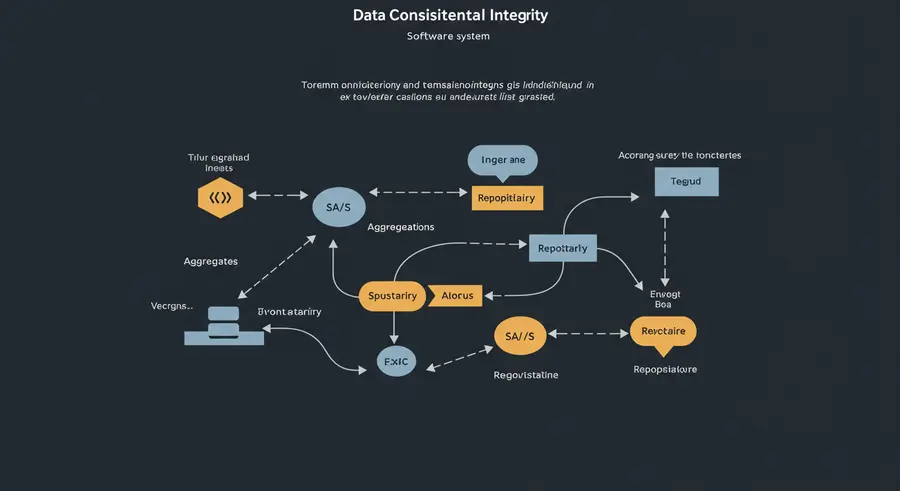Data Consistency and Transactional Integrity in Domain-Driven Design
One of the paramount challenges in developing complex software systems is maintaining data consistency and ensuring transactional integrity. In the realm of Domain-Driven Design (DDD), where the focus is on modeling complex business domains, these aspects are not just technical concerns but fundamental to accurately representing the domain's rules and invariants.

The Challenge of Consistency
In distributed systems, microservices architectures, and even complex monolithic applications, ensuring that all parts of the system reflect the correct state of the domain can be challenging. Traditional ACID transactions (Atomicity, Consistency, Isolation, Durability) work well within a single database or service, but they often break down when operations span multiple services or Bounded Contexts. This is where DDD offers specific patterns and principles to manage consistency at a higher, more strategic level.
Aggregates: The Cornerstone of Transactional Integrity
At the tactical design level, DDD introduces the concept of an Aggregate. An Aggregate is a cluster of associated objects treated as a unit for data changes. It has a single Aggregate Root, which is an Entity, and the only object external clients are allowed to hold references to. All operations that modify the state within an Aggregate must go through the Aggregate Root, ensuring that all invariants (business rules that must always be true) within that Aggregate are maintained.
The key principle here is that one transaction = one Aggregate instance. This means that any operation that changes an Aggregate's state should be atomic and consistent. By enforcing this rule, DDD simplifies the consistency problem, limiting transactional boundaries to well-defined Aggregate boundaries.
Example: Order Aggregate
Consider an Order Aggregate. It might include OrderLine items and a reference to a Customer. When an order is placed, updated, or canceled, all changes to the order lines and the order's status must be handled by the Order Aggregate Root. This ensures that an order can never be in an inconsistent state (e.g., an order with line items but no total amount, or a total that doesn't match the sum of its line items).
Repositories: Bridging the Gap
Repositories are another tactical pattern that work hand-in-hand with Aggregates to ensure data consistency. A Repository is an abstraction that mediates between the domain model and the data mapping layer. It provides methods to retrieve and persist entire Aggregates. Critically, a Repository should only handle Aggregates, not individual Entities or Value Objects within an Aggregate. This reinforces the Aggregate's transactional boundary and ensures that when an Aggregate is saved, all its parts are persisted consistently.
Domain Events: Eventual Consistency Across Bounded Contexts
While Aggregates ensure strong consistency within a single Bounded Context, what happens when an operation impacts multiple Bounded Contexts? For instance, when an Order is placed in the "Sales" Bounded Context, it might need to trigger actions in the "Inventory" Bounded Context (to reserve stock) and "Shipping" Bounded Context (to prepare for delivery).
For such cross-context communication, DDD often leverages Domain Events. A Domain Event signifies that something significant has happened in the domain. When an Aggregate's state changes, it can publish a Domain Event (e.g., OrderPlacedEvent). Other Bounded Contexts can then subscribe to these events and react accordingly. This approach leads to eventual consistency, where data across different contexts will eventually become consistent, rather than being immediately consistent within a single distributed transaction.
This pattern avoids the complexities and performance bottlenecks of distributed transactions, promoting a more loosely coupled architecture—a hallmark of modern systems like microservices. For more insights on financial architectures, you might find how AI-powered financial platforms leverage consistent data for market analysis and portfolio management relevant. Exploring advanced patterns of distributed transactions can provide further depth.
Consistency Across the Entire System
Managing consistency in DDD involves a multi-faceted approach:
- Within an Aggregate: Strong consistency via the Aggregate Root and its invariants, enforced by a single transaction.
- Within a Bounded Context: Strong consistency for operations affecting multiple Aggregates can sometimes be achieved if they fall under the same transactional boundary, though this is less common and often implies a need for re-evaluating Aggregate design.
- Across Bounded Contexts: Eventual consistency achieved through Domain Events and asynchronous communication. Sagas and Process Managers can help orchestrate longer-running business processes that span multiple contexts.
By consciously choosing the right consistency model for each level, DDD helps design systems that are both robust and performant, avoiding the pitfalls of over-engineering immediate consistency where eventual consistency is sufficient.
Understanding these mechanisms is crucial for anyone building resilient and scalable applications with Domain-Driven Design. It allows developers to create software that truly reflects the complexities of the business domain while maintaining data integrity across all its components. You can learn more about related concepts on Wikipedia's ACID page.